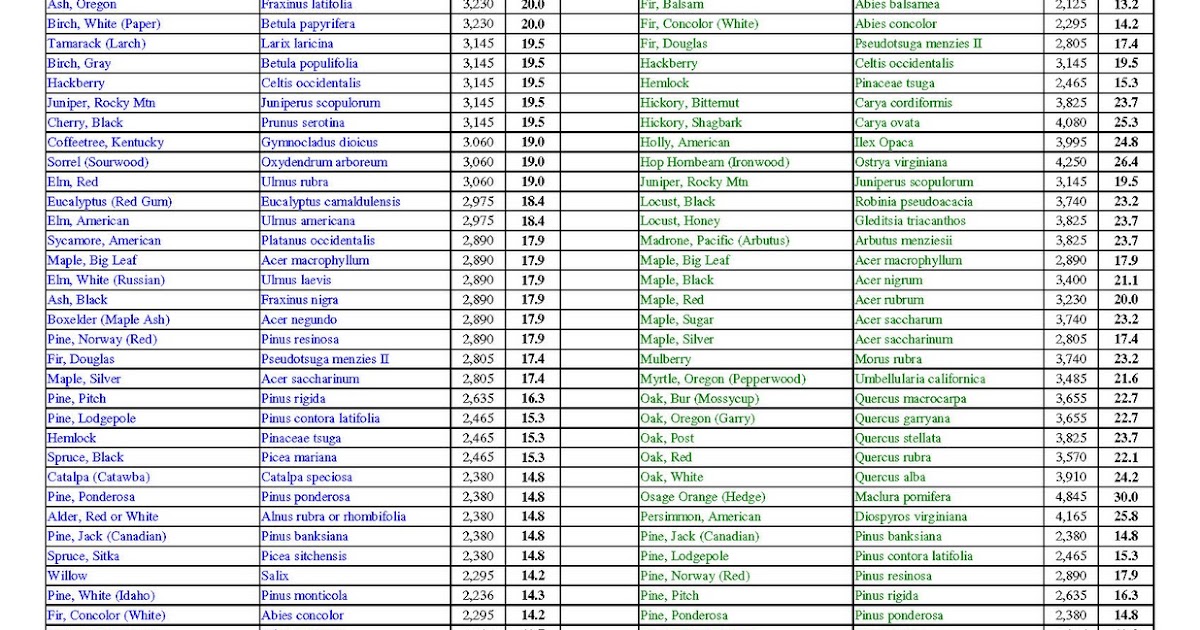The Wood BTU Chart is an essential tool for anyone looking to understand the energy content of various types of wood. Knowing the BTU (British Thermal Unit) value of wood can help you make informed choices when it comes to heating your home, cooking, or even using wood for outdoor activities. In this article, we will delve into the intricacies of the Wood BTU Chart, its importance, and how it can aid you in selecting the right type of wood for your needs. With the rising interest in sustainable living and efficient energy use, understanding wood's energy output is more crucial than ever.
In the following sections, we will explore the various types of wood, their respective BTU values, and how factors such as moisture content can affect performance. We will also discuss the practical applications of the Wood BTU Chart and provide insights into its significance for different users, whether you are a homeowner, a contractor, or an outdoor enthusiast.
By the end of this article, you will have a solid understanding of the Wood BTU Chart, enabling you to make better decisions regarding wood selection and usage. Let's dive into the world of wood energy content!
Table of Contents
- What is BTU?
- Importance of BTU in Wood Selection
- Understanding the Wood BTU Chart
- Types of Wood and Their BTU Values
- Factors Affecting BTU Values
- Practical Applications of Wood BTU Chart
- How to Use the Wood BTU Chart
- Conclusion
What is BTU?
BTU, or British Thermal Unit, is a unit of measurement used to quantify energy. Specifically, it refers to the amount of energy needed to raise the temperature of one pound of water by one degree Fahrenheit. In the context of wood, BTU values indicate the amount of heat energy that can be released when the wood is burned.
Understanding BTUs is crucial for evaluating the efficiency of different heating sources, including wood. Higher BTU values mean that a type of wood will produce more heat when burned, making it a more efficient option for heating or cooking.
Importance of BTU in Wood Selection
When selecting wood for heating or cooking, the BTU value is a critical factor to consider. The importance of BTU in wood selection includes:
- Efficiency: Choosing wood with a high BTU value ensures that you get more heat from less wood, translating to cost savings and lower environmental impact.
- Burn Time: Different woods burn for different lengths of time, and higher BTU woods typically have longer burn times.
- Heat Output: Understanding BTUs allows users to better match their heating needs with the right type of wood.
Understanding the Wood BTU Chart
The Wood BTU Chart provides a reference for the energy content of various types of wood. It lists different wood species along with their average BTU values. This chart is invaluable for anyone who wants to optimize their wood usage based on energy needs.
Typically, the chart categorizes wood into hardwoods and softwoods, with hardwoods generally having higher BTU values than softwoods. This is due to the density and composition of the wood fibers.
Types of Wood and Their BTU Values
Here is a brief overview of some common types of wood and their corresponding BTU values:
| Type of Wood | BTU Value (per cord) |
|---|---|
| Oak (Red) | 25 million BTUs |
| Maple | 24 million BTUs |
| Hickory | 27 million BTUs |
| Pine | 15 million BTUs |
| Birch | 20 million BTUs |
Factors Affecting BTU Values
Moisture Content
The moisture content of wood significantly affects its BTU value. Wood that is freshly cut or "green" can have a moisture content of up to 50%, which reduces its efficiency as a fuel source. Ideally, firewood should be seasoned, meaning it has been dried for at least six months, to achieve optimal burning conditions.
Wood Density
Denser woods tend to have higher BTU values because they contain more material to burn. This is why hardwoods generally outperform softwoods in terms of energy output.
Practical Applications of Wood BTU Chart
The Wood BTU Chart can be useful in several scenarios:
- Home Heating: Homeowners can use the chart to select the best wood for their stoves or fireplaces, maximizing heat output.
- Cooking: When choosing wood for outdoor grilling or smoking, understanding the BTU values can improve flavor and cooking efficiency.
- Commercial Uses: Contractors and builders can consider BTU values when selecting materials for large-scale heating systems.
How to Use the Wood BTU Chart
Using the Wood BTU Chart is straightforward:
- Identify your heating or cooking needs.
- Refer to the chart to find the BTU values for different wood types.
- Choose a wood type that matches your needs in terms of BTU output and availability.
Conclusion
In summary, the Wood BTU Chart is an essential resource for anyone involved in wood burning, whether for heating or cooking purposes. Understanding the energy content of wood helps in making informed choices, leading to better efficiency and cost savings.
We encourage you to explore various wood types and their BTU values to find the best fit for your needs. If you have any questions or want to share your experiences, feel free to leave a comment below!
Thank you for reading, and we hope you found this article informative. Be sure to check out our other articles for more insights and tips on wood usage and energy efficiency!
Where Are Dragonborn In Eberron: A Comprehensive Guide
Exploring The Culinary Delights Of Sharks, Fish, And Chicken
Garden Bros Nuclear Circus: An Unforgettable Experience


